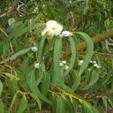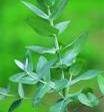| Kingdom | Plantae |
| Unranked | Angiosperms |
| Unranked | Eudicots |
| Order | Myrtales |
| Family | Myrtaceae |
| Genus | Eucalyptus |
| Species | E. globulus |
| Binomial name | Eucalyptus globulus |
Other Common Names:
The other common names for the eucaluptus tree are the Tasmanian Blue Gum, Southern Blue Gum or Blue Gum Eucalyptus (Bluegum eucalyptus) evergreen tree.
History
The tree was introduced into California in 1856 and into Hawaii in about 1865 and has naturalized in both state, especially in areas of coastal fog. It is one of the world's most valuable windbreak trees and is a major source of fuelwood in many countries. It comes from the Myrtaceae (myrtle) botanical family and is native to Tasmania and southeastern Australia and Brazil.

Description
It is an evergreen tree 40-70 m tall with straight massive trunk 0.6-2 m in diameter with narrow, irregular crown of large branches and drooping aromatic, camphoraceous foliage. Root system deep and spreading. It has grey-white bark. On young trees or new branches of older trees grow opposite, thin, ovate leaves, whereas the mature types of leaves are alternate, twice as thick, leathery, and much longer, with petioles. The principal vein is quite prominent on the blue-green under-side of the leaf, and it branches at a right angle. The secondary veins join to form an unforked marginal vein (craspedromus) that runs parallel to the leaf margin.


Range
Eucalyptus is a tree with fragrant grey-green foliage originally from Australia (Tasmania) that can reach a height of 90m. It is also found in Europe, Africa and Latin America. The planted range in California extends from Humboldt County south to San Diego County, with best growth in the coastal fog belt near San Francisco. The Eucalyptus, especially E. globulus, has been successfully introduced into the south of Europe, Algeria, Egypt, Tahiti, South Africa and India, and has been extensively planted in California and also, with the object of lessening liability to droughts, along the line of the Central Pacific Railway.
Habitat
Eucalyptus thrives best in damp marshy areas on moist loams and clays. It is generally found in hilly country or moist valleys in deep rich soils. Their chief habitat are bog garden, woodland, sunny edge and dappled shade.
Cultivation
Fresh seeds germinate well but deteriorate rapidly. The tree is readily established, easily reproducing from self-sown seed. In California, seed collections from a single tree exhibit wide variation (2-80%) in germinative capacity after a 30-day germination period. Seedlings like the adults are susceptible to drought, fire, and frost. Grasses need to be weeded, as the tree does not compete well with grasses. Tree grows rapidly and coppices readily reaching a meter or more in a few months. Seeds are surface sown in February/March in a sunny position in a greenhouse. Species that come from high altitudes appreciate 6 - 8 weeks cold stratification at 2°c Pot up the seedlings into individual pots as soon as the second set of seed leaves has developed, if left longer than this they might not move well. Plant out into their permanent positions in early summer and give them some protection from the cold in their first winter. The seed can also be sown in June, the young trees being planted in their final positions in late spring of the following year. The seed has a long viability. Plants are shallow-rooting and, especially in windy areas, should be planted out into their permanent positions when small to ensure that they do not suffer from wind-rock. They strongly resent root disturbance and should be container grown before planting out into their permanent position.
Flowering Season
The scented white flowers which are hermaphrodite are in bloom from July to August.
Pests and Diseases
Coffea arabica is a delicate plant which is plagued by more than 40 diseases caused by fungi, viruses, bacteria, and soil deficiencies. The worst disease is leaf rust caused by the fungus Hemileia vastatrix. The leaves die and drop off, and after a few years the bush dies. Leaf rust damage is a problem almost everywhere except in Central and South America, where farmers destroy the plants at the first sign of the disease. This success in fighting leaf rust explains why most Arabica coffee is grown there. Other, less serious diseases do occur, but mostly where growing conditions are marginal.
Parts Used

The eucalyptus oil, leaves and the bark are the most commonly used parts of the tree for its commercial and medicinal purposes.
Medicinal Applications


• Eucalyptus is best known as a decongestant inhalation for colds and catarrh.
• Eucalyptus with Bergamot is useful for treating cold-sores and genital herpes, caused by the herpes simplex virus, and for the blisters occurring in shingles, which is due to the same virus as chickenpox -herpes zoster.
• Eucalyptus can be used in massage to relieve pain in rheumatism, muscular aches and fibrositis.
• Eucalyptus globulus (eucalyptus) is used as a traditional treatment for diabetes.
• Eucalyptus has a camphorous and woody scent and is a powerful antiseptic, widely used in baths and massage during the cold season.
• Eucalyptus, especially the blue gum variety, helps with sunburn.
• It is good for nasal decongestion and blends well with Rosemary and Sweet Marjoram, which are the classic muscular ache oils.
• It is useful also in gonorrhea and in gleet and as a wash in specific vaginitis.
• This suppository is of value in uterine cancer. It relieves pain and corrects the odour of the discharges.
• Eucalyptus Oil is used as a stimulant and antiseptic gargle.
Commercial Applications


• Eucalyptus deters mosquitoes and insects in general.
• It can act as a deodorant and flea- deterrent on dogs.
• It is used as an insect repellent.
• The pulp of the eucalyptus tree is used the manufacturing of paper industry.
• It is used in perfumery and in medicines.
• The timber is used for various purposes such as carpentry, construction, fences, piles, platforms, plywood, poles, sheds, tool handles and veneer.
• The oil is used as a flavouring agent in cold and cough medicines.
• It is used in disinfectants, antiseptic liniments, ointments, toothpastes, and mouthwashes.
• It is used by veterinarians for treating influenza in horses, distemper in dogs, and septicaemia in all animals.
• Blue gum eucalyptus oil is used as a flavour ingredient in boiled sweets and food products such as beverages, dairy desserts, candy, baked goods, gelatins, puddings, and meat products.
• The cosmetic industry uses it as a fragrance component in soaps, detergents, air fresheners, bath oils, and perfumes.

This species is the national emblem of Tasmania. There is a festival called Maskal celebrated in the spring in Ethiopia and that day is considered as a religious holiday. The highlight of the Maskal celebration is the burning of a tall bonfire, which consists of sticks of eucalyptus, tree branches, and tree trunks all tied together. After dark, it is burned as part of the Maskal celebration. The event is attended by the church and army, including dignitaries from the court, soldiers, and the Bishop. The humble townspeople watch the court celebration on the very holy day.
Aromatherapists consider eucalyptus to be cleansing and will use the oil to remove negative energies. They believe that eucalyptus brings a sense of renewal to a space and often recommend that new homeowners diffuse it in their new homes to remove the previous family's emotional energy. They will also recommend eucalyptus for people who feel internally conflicted or are struggling in their relationships with others. The Australian aboriginals were said to believe the trees had mystical powers.